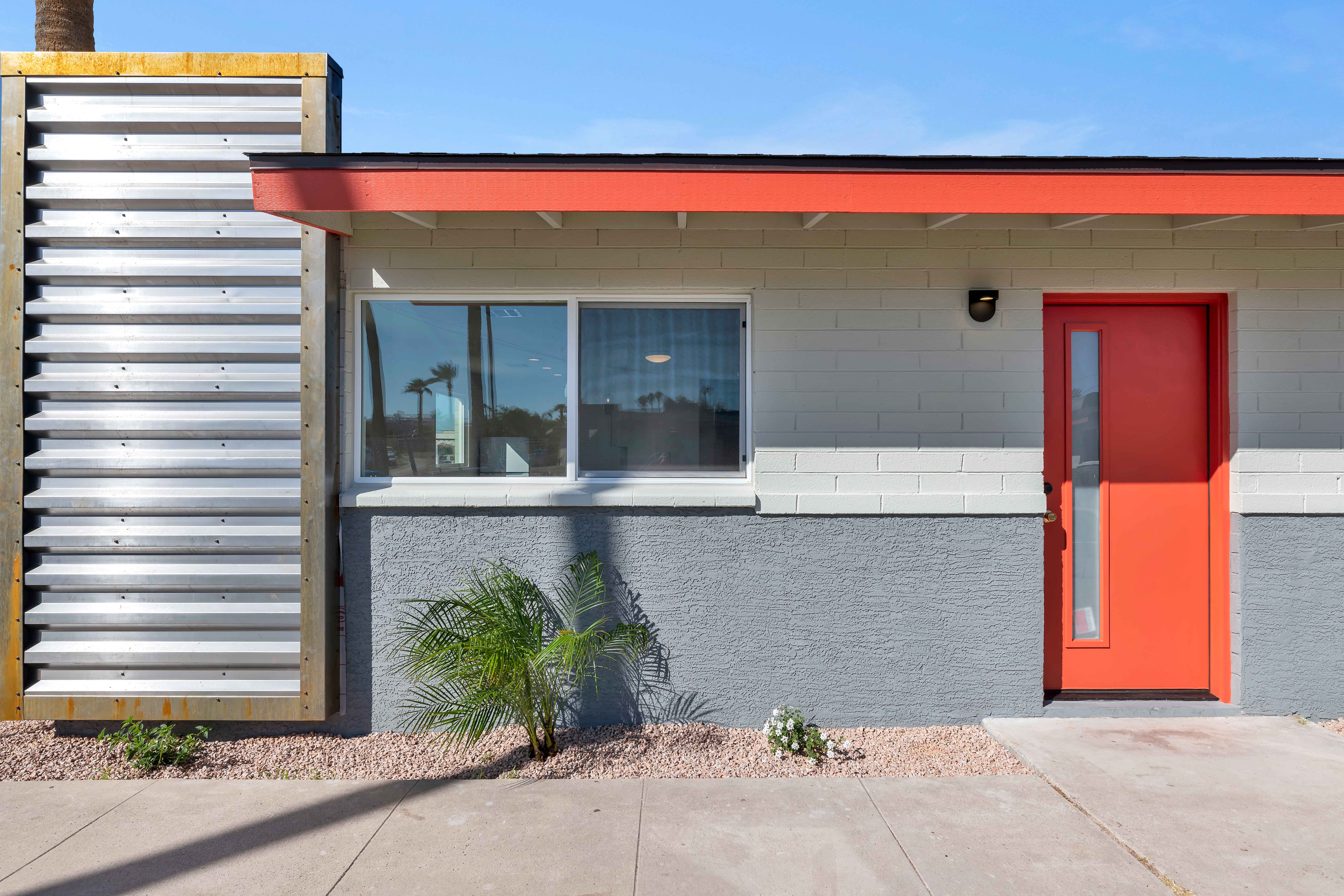– BREAKING NEWS – EXECUTIVE ORDER 2020-18
COVID-19 HULL, HOLLIDAY & LEGAL HOLLIDAY— ATTORNEY NEWS 
DENISE HOLLIDAY
“STAY HOME, STAY HEALTHY, STAY CONNECTED” EFFECTIVE 03/31/2020, AT 5:00PM THROUGH APRIL 30,
IMPACT ON RESIDENTIAL RENTAL INDUSTRY, AN UPDATE UPDATED—April 7, 2020
To Our Valued Clients: Unless you are living on a private island, your life has been impacted over the past few weeks as a result of COVID-19 and the reaction by both the government and private citizens. It is an odd sensation to walk into a store only to find a large number of empty shelves and people wandering around with worried and panicked looks. Most Americans have never experienced empty shelves and the closure of businesses and schools, even though we hope and pray it is only temporary. Because we don’t have hurricanes, tornados, earth- quakes, or tsunamis, many Arizonans have never experienced a disaster that has been more than a mere an- noyance in our daily lives (even the occasional “Haboob” is over quickly).
Over the past few weeks all levels of the government have implemented many changes to the way we do busi- ness. On a hopeful note, on March 27, 2020, the President signed the CARES Act which may offer a reprieve to many of you and your businesses. This very important law is discussed in detail below and in a second Guidance Memorandum that we are preparing for our clients. We hope that our email blasts are helpful in guiding you through this tumultuous time in our industry. Below are the most important changes that have oc- curred in the past week. This information is what you need to know if you own or manage rental property.
Arizona Changes IMPORTANT UPDATE—All Commercial Evictions Stopped by April 6 Executive Order. On April 6, 2020, Arizona Governor Ducey issued another executive order stopping all commercial evictions. The order specifically prohibits any eviction action “including lock out, notice to vacate, or any other attempt to inhibit the operations of small business.” The Governor’s intent is to provide relief to small businesses statewide im- pacted by the COVID-19 pandemic. The suspension of these evictions runs through May 31, 2020 and pro- tects commercial tenants with fewer than 500 employees and all manner of entities including sole proprietor- ships, partnerships, C-corps, S-corps, LLCs, independent contractors, the self-employed, 501(c) (3) entities, 501(c)(19) entities, and tribal businesses. Any actions instigated prior to the March 11 State of Emergency order may continue, but any actions that began after that date are suspended.
Housing Providers and Real Estate Professions are deemed “Essential Services”: On March 23, 2020, Governor Ducey issued Executive Order 2020-12, intended to provide our state with a consistent, overarch- ing policy of the businesses and operations he deemed “essential” and such services would continue to be provided to the citizens of the state of Arizona. We are pleased that the Governor recognized that housing providers and real estate professionals are a critical facet of Arizona housing industry, as are the trade per- sons that aid in the maintenance of the residential rental industry. The reason Executive Order 2020-12, is an important directive is obvious – without property management and maintenance professionals being able to leave their homes and supply the necessary services, serious health and safety issues would impact the lives of our residents and cause potentially irreparable harm to the premises. On April 3, 2020, the Governor clari- fied in a public statement that apartment pools, gyms, etc. must remain closed.
Postponement of Non-Payment Evictions for Renters that have been negatively impacted by COVID- 19: On March 24, 2020, through Executive Order 2020-14, the Governor surprised everyone by issuing an order that all constables and sheriff deputies temporarily delay the enforcement of a non-payment of rent eviction (the lockout) if the tenant notified the landlord in writing that they are suffering hardship as a result of the coronavirus. EO 2020-14 is clear that all other types of residential evictions (Immediates, Health and Safety breaches, regular material Non-Compliances situations, and Material Falsification of the application) may continue in the normal fashion. If the landlord disagrees with the constable’s decision, they may apply for an emergency hearing that would require the tenant to provide proof that the tenant qualifies for the pro- tections of the EO 2020-14. As a reminder, despite a misstatement by the Governor during a recent town hall meeting, the Executive Order allows landlords to require proof that the tenant qualifies for an extension of time before the Writ can be executed.
Arizona Changes, continued… Arizona Supreme Court orders all Maricopa County evictions to be heard telephonically as of March 31, 2020: In Administrative Order 2020-048, all Maricopa County evictions (both the initial appearance and the trial) must be heard telephonically. Many courts had already taken similar steps to help reduce the spread of the coronavirus, but AO 2020-048 clarified that even Immediate evictions and all trials are now re- quired to be conducted telephonically until April 17, 2020. This will require all clients to ensure that their wit- nesses are prepared to testify telephonically and that our firm has all the evidence needed for the trial at least one day in advance so that we can provide a copy to the court and the tenant. You will be provided a phone number to call into the court so please follow those instructions. The virtual courtrooms have numerous par- ties and hearings occurring at the same time, so please be patient and mute your phone until you hear that your case has been called.
$50 Million in New Rental Assistance: The Department of Housing launched this new funding as of March 30, 2020. This initial $50 million will be paid out of the State Housing Trust Fund. The process to apply has been streamlined at www.azhousing.gov. For renters that do not have internet access, they can call their lo- cal Community Action Agency. For a complete list, contact our office. We have created a working list of all the Arizona agencies and private businesses that can provide rental, utility, and food assistance. We encour- age you to get a copy and provide it to all residents. You may attach it to the five-day non-payment of rent notice or provide it when entering into a partial payment agreement with your resident.
Extensions of certain licensing requirements: Executive Order 2020-17 mandates that state agencies and boards extend the time frames for licensing and eliminates barriers to online classes. This was a critical issue for the real estate professionals that are required to complete licensing requirements while this pan- demic interferes with their ability to take the necessary classes etc.
Federal Changes Families First Coronavirus Response Act (FFCR): HR 6201 went into effect on April 2, 2020 and remains in effect until December 31, 2020. The biggest changes that impact owners and real estate professionals are the Emergency Paid Sick Leave and expanded FMLA provisions. In a move rarely seen by Congress, these laws specifically target the small business owner in that it only applies to employers with fewer than 500 employees. The Emergency Paid Leave Act applies to any company regardless of how long that employee has worked there. It provides a list of qualified reasons the employer must provide paid sick leave (all of the reasons listed as COVID-19 related), including caring for a sick family member or a minor child because the schools are closed. Full time employees are eligible for an additional 80 hours of paid sick leave on top of the mandatory paid sick leave currently required by federal law. Part-time employees are entitled to the equivalent of the hours they would have worked during a two-week period. The amount they must be paid is dependent on which qualifying reason the employee invoked. The employer cannot require the employee to first use all other paid leave provided by the employers prior to the Act. The employer can seek reimbursement for the wages paid to the employee through a tax credit applicable to the employer’s portion of Social Security taxes (seek advice from your tax professional).
Emergency Expansion of FMLA: The FFCR also includes the Emergency Family and Medical Lease Expansion Act which provides a new source of paid leave for eligible employees whose child’s school or place of care has closed due to COVID-19. Usually FMLA applies only to companies who employ 50 or more employees that have worked there for at least 12 months and worked at least 1250 hours during the previous 12 months. This new emergency expansion now applies to all employers who have less than 500 employees that have worked at least 30 days. Under the new law, an eligible employee can take up to 12 weeks (some of which may be unpaid). There is a special way to become exempt if you have fewer than 50 employees if you apply with the Secretary of Labor. A word of caution: This section is included as a courtesy, but our firm doesn’t practice in the area of labor law. If you employ less than 500 employees, you need to be aware of these changes and you are encouraged to seek specific advice from your HR specialist/legal advisor.
Federal Changes, continued…
Coronavirus Aid, Relief, and Economic Security Act (CARES Act): President Trump signed the CARES Act into law on March 27, 2020. Among the trillions of dollars addressed in the Act, several portions will critically impact the residential rental industry. We have drafted separate cover sheets for each of those issues so please review each of those for the specifics of each section, but here is a quick summary:
– Section 4024 Non-Payment Eviction Moratorium: There is now a temporary moratorium on certain eviction filings for 120 days. The types of evictions impacted are only for non-payment of rent and only for new filings so all existing evictions can proceed (although the lockout may be impacted by EO 2020-14 discussed above). Covered properties include any property that is insured, guaranteed, supplemented or assisted in any way by HUD, FHA, Fannie Mae or Freddie Mac, or participate in PRAC 202 or 811, HOOWA, McKinney-Vento, Section 236, accepts Section 8, rural housing assistance program or LIHTC. The Act prohibits the landlord filing a non-payment of rent eviction and charging late fees. If you are subject to the law, it will require you to modify your nonpayment of rent notice. There is also an odd provision that stops landlords from issuing any new non-renewal notices for 120 days. Check your loan documentation if you are unsure if this applies to you.
– Section 4022 and 4023 Forbearance of residential mortgages. This portion of the Act addresses the forbearance (temporary relief from timely paying) of a single family home and a separate section addressing multifamily properties. The purpose behind these two sections is to provide the owner of rental property that has a federally backed mortgage some temporary relief due to the eviction moratorium discussed above.
– Section 1102 Paycheck Protection Program: This section is designed to help small business owners (those with less than 500 employees) keep their employees on their payroll through June 30, 2020. It is available not just to traditional small businesses, but also to those who are self-employed, independent contractors, and sole proprietors. In general, the employee can apply for an SBA loan as well as an Emergency EIDL Grant, to help pay the payroll, mortgage interest or rent, utilities, and some other recurring debt. Unlike most SBA loans, the loan is non-recourse (unless the money is not used for the required purpose), does not require a personal guarantee or collateral, and does not require the borrower to prove they have exhausted other loan possibilities. The beauty of this portion of the Act is that the loan can be completely forgiven pursuant to section 1106 as long as all requirements are met. There is also an emergency grant available for businesses that have been in business at least one year that is based upon your credit score rather than tax returns. It is designed to help you immediately cover your payroll, sick leave, mortgage/rent, utilities and other urgent financial needs.
We recognize that some of the paperwork required to take advantage of some of these programs may be daunting for the small business owner. We are able to help our clients navigate those procedures, prepare all the necessary paperwork, and help you submit it to the proper agency.
Conclusion and Personal Greetings Please take the time to read and understand this important update. Timely and accurate information about the industry is critical to protect you, your business, and your residents. We understand that these are difficult times and things are changing from day to day. Our first hope and prayer is that each and every one of you stay safe and healthy during this time. You are important to us. Your business is important to us. We will continue to be here to provide you with these updates and advice that is tailored to you and your company’s legal needs. We will endeavor to be prompt in our responses and at the same time continue to give you the most up to date advice when it becomes available. See our contact information below. Remember, we’re all in this together!
HULL, HOLLIDAY & HOLLIDAY 602-230-0088 holliday@h3landlordlaw.com










 Courtesy signing appointments at branch locations are currently unavailable. Some of our vital services or affiliates may not be available or you may experience less than normal response times due to the current circumstances. It is our intention to continue to provide our services within the restrictions placed upon us all by the Pandemic.
Courtesy signing appointments at branch locations are currently unavailable. Some of our vital services or affiliates may not be available or you may experience less than normal response times due to the current circumstances. It is our intention to continue to provide our services within the restrictions placed upon us all by the Pandemic.


